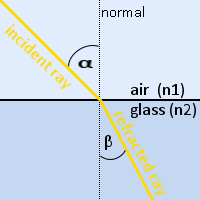
Refraction
If a ray of light hits the boundary of two different media diagonally, it will be refracted there. The ray of light changes its direction of propagation and gets a kink.
The reason for this is that rays of light can propagate at different velocities in different materials. For example, light moves faster in the air than in the water so that it is deflected while entering the water. In the course of this every substance, which can be passed through by light, is called medium.

Law of refraction
The level of the refraction of the ray of light depends on the incidence angle of the light and the two substances. The refraction happens according to fixed rules, which can be represented in a formula. If the angle of incidence at the boundary and the refractive index n of the media are known, the path of the ray of light behind the boundary in the second medium can be calculated:
![]() .
.
The ray of light is refracted to a higher degree,
If a ray of light enters glass at an incidence angle of 45°, it propagates at an angle of approximately 62° in water (as you can see in the picture).
Substance/Material |
Refractive index at 20°C. |
Air |
1 |
Water |
1,33 |
Glass |
approximately 1,5 |
Diamond |
2,47 |
refractive indices
Oppositely, you can see a collection of some examples of refractive indices of different kinds of subustances.
The slower the light propagtes in a certain medium, the higher is its refractive index.
